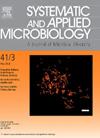波兰Tatra山Szczelina Chochołowska洞穴月乳中分离的放线菌Streptomyces tritrimontium sp. nov.的多相分类描述和对Streptomyces manipurensis Nimaichand等人2021和nojiriensis Ishida等人1967的修正描述
IF 4.2
2区 生物学
Q2 BIOTECHNOLOGY & APPLIED MICROBIOLOGY
引用次数: 0
摘要
本文采用多相分类学方法确定了波兰Tatra山Szczelina Chochołowska洞穴月乳中分离的两株链霉菌的分类位置。菌株2.9T和4.24的形态特征和化学分类特征与它们在链霉菌属中的分类一致。它们是革兰氏染色阳性丝状细菌,形成广泛分支的底菌丝体和表面光滑的直长链孢子。它们在整个生物体水解物中含有l -二氨基苯甲酸、葡萄糖和核糖,产生主要比例的直、异和反异脂肪酸,六氢化和八氢化具有九个异戊二烯单位的甲基萘醌,并与磷脂酰乙醇胺(诊断脂质)具有极性脂质模式。菌株2.9T和4.24在Streptomyces 16S rRNA基因树中形成了一个独立的分支,与Streptomyces stoeckheimensis DSM 116496序列具有100%的相似性。菌株2.9T和4.24及其亲缘关系较近的邻居株全基因组序列的平均核苷酸同一性(ANI)和数字DNA-DNA杂交(dDDH)值分别为90.4%和36.3%,表明它们属于不同的基因组种。因此,基于基因组学、系统发育和相关表型数据,我们建议将菌株2.9T和4.24归入链霉菌属,以菌株2.9T (DSM 119353T = PCM 3548T)为型菌株。菌株2.9T和菌株4.24的基因组中含有较多的生物合成基因簇(分别为28和27个),其中一些基因簇呈不连续分布,表明它们可能表达新的特化代谢物。在本研究中获得的数据也被用于修正操纵链霉菌和野尻链霉菌的描述。本文章由计算机程序翻译,如有差异,请以英文原文为准。
Polyphasic taxonomic description of Streptomyces tritrimontium sp. nov., actinomycetes isolated from moonmilk in Szczelina Chochołowska cave of Tatra Mountains in Poland and emended descriptions of Streptomyces manipurensis Nimaichand et al. 2021 and Streptomyces nojiriensis Ishida et al. 1967
In the present study the taxonomic position of two streptomycete strains, isolated from moonmilk in Szczelina Chochołowska cave located in Tatra Mountains in Poland, was established using a polyphasic taxonomic approach. Strains 2.9T and 4.24 have morphological characteristics and chemotaxonomic properties consistent with their classification in the genus Streptomyces. They are Gram-stain-positive filamentous bacteria which formed an extensively branched substrate mycelium and straight long chains of smooth surfaced spores. They contain LL-diaminopimelic acid, glucose and ribose in whole-organism hydrolysates, produce major proportions of straight, iso- and anteiso- fatty acids, hexa- and octa‑hydrogenated menaquinones with nine isoprene units and have a polar lipid pattern with phosphatidylethanolamine (diagnostic lipid). Strains 2.9T and 4.24 formed a distinct clade within the Streptomyces 16S rRNA gene tree sharing 100 % sequence similarity with Streptomyces stoeckheimensis DSM 116496ᵀ. Average nucleotide identity (ANI) and digital DNA-DNA hybridization (dDDH) values calculated from the whole genome sequences of strains 2.9T and 4.24 and their closely related phylogenomic neighbour were found to be 90.4 and 36.3 %, respectively, indicating that they belong to different genomic species. Consequently, based on the genomic, phylogenetic and associated phenotypic data it is proposed that strains 2.9T and 4.24 be assigned to the genus Streptomyces as Streptomyces tritrimontium sp. nov. with strain 2.9T (DSM 119353T = PCM 3548T) as the type strain.
The genomes of strains 2.9T and 4.24 contain relatively high number of biosynthetic gene clusters (28 and 27, respectively), some of which were discontinuously distributed, indicating ones predicted to express for novel specialized metabolites.
Data acquired in the present study have also been used to emend the descriptions of Streptomyces manipurensis and Streptomyces nojiriensis.
求助全文
通过发布文献求助,成功后即可免费获取论文全文。
去求助
来源期刊

Systematic and applied microbiology
生物-生物工程与应用微生物
CiteScore
7.50
自引率
5.90%
发文量
57
审稿时长
22 days
期刊介绍:
Systematic and Applied Microbiology deals with various aspects of microbial diversity and systematics of prokaryotes. It focuses on Bacteria and Archaea; eukaryotic microorganisms will only be considered in rare cases. The journal perceives a broad understanding of microbial diversity and encourages the submission of manuscripts from the following branches of microbiology:
 求助内容:
求助内容: 应助结果提醒方式:
应助结果提醒方式:


